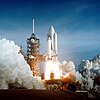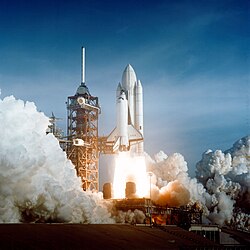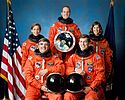STS-32
| Missionsemblem | |||
|---|---|---|---|
 | |||
| Missionsdaten | |||
| Mission | STS-32 | ||
| NSSDCA ID | 1990-002A | ||
| Besatzung | 5 | ||
| Start | 9. Januar 1990, 12:35:00 UTC | ||
| Startplatz | Kennedy Space Center, LC-39A | ||
| Landung | 20. Januar 1990, 09:35:36 UTC | ||
| Landeplatz | Edwards Air Force Base, Bahn 22 | ||
| Flugdauer | 10d 21h 0 m 36s | ||
| Erdumkreisungen | 172 | ||
| Bahnhöhe | 330 km | ||
| Bahnneigung | 28,5° | ||
| Zurückgelegte Strecke | 7,2 Mio. km | ||
| Nutzlast | SYNCOM IV-F5 (LEASAT 5), LDEF | ||
| Mannschaftsfoto | |||
 v. l. n. r. Marsha Ivins, Daniel Brandenstein, David Low, James Wetherbee, Bonnie Dunbar | |||
| ◄ Vorher / nachher ► | |||
| |||
STS-32 (englisch Space Transportation System) ist eine Missionsbezeichnung für das US-amerikanische Space Shuttle Columbia (OV-102) der NASA. Der Start erfolgte am 9. Januar 1990. Es war die 33. Space-Shuttle-Mission und der neunte Flug der Raumfähre Columbia.
Mannschaft
- Daniel Brandenstein (3. Raumflug), Kommandant
- James Wetherbee (1. Raumflug), Pilot
- Bonnie Dunbar (2. Raumflug), Missionsspezialistin
- David Low (1. Raumflug), Missionsspezialist
- Marsha Ivins (1. Raumflug), Missionsspezialistin
Missionsüberblick
Die 33. Space-Shuttle-Mission begann am 9. Januar 1990 um 12:35 UTC. Dies war der erste Start von Startrampe 39A seit dem Unglück der Raumfähre Challenger im Januar 1986. Seither wurden einige Änderungen an dieser Startrampe vorgenommen, um die Sicherheit für die Mannschaft zu erhöhen. Der Start war ursprünglich für den 18. Dezember 1989 geplant, musste jedoch um etwa drei Wochen verschoben werden, weil die letzten Arbeiten und Tests an der Rampe nur mit Verspätung durchgeführt werden konnten.

Ziel der Mission war es, den militärischen Kommunikationssatelliten SYNCOM IV-F5 (auch als LEASAT 5 bekannt) auszusetzen und die Long Duration Exposure Facility (LDEF) der NASA mit Hilfe des Roboterarms einzufangen und zur Erde zurückzubringen. Diese Experimentierplattform war seit April 1984 im Orbit und enthielt über 50 Experimente. Eigentlich hätte die LDEF nur einen etwa zehnmonatigen Flug durchführen sollen, durch das Challenger-Unglück und die daraus resultierenden Verspätungen in Shuttleprogramm blieb die Plattform jedoch über fünf Jahre im All.
Die Missionsziele konnten von der Crew erfolgreich erfüllt werden, die Landung erfolgte am 20. Januar in Edwards AFB, Kalifornien. Die Columbia wurde später mittels eines Spezialflugzeuges, einer umgebauten 747-100 Shuttle Carrier Aircraft, nach Cape Canaveral, Florida zurücktransportiert. Die 747-100 mit der Columbia landete am 26. Januar um 21:30 UTC auf der Landebahn im Kennedy Space Center.
Siehe auch
- Liste der Space-Shuttle-Missionen
- Bemannte Raumfahrt
- Liste der Raumfahrer
- Liste der bemannten Raumflüge
Weblinks
- Videozusammenfassung mit Kommentaren der Besatzung (englisch)
- NASA-Missionsüberblick (englisch)
- STS-32 in der Encyclopedia Astronautica (englisch)
Auf dieser Seite verwendete Medien
The April 12 launch at Pad 39A of STS-1, just seconds past 7 a.m., carries astronauts John Young and Robert Crippen into an Earth orbital mission scheduled to last for 54 hours, ending with unpowered landing at Edwards Air Force Base in California.
STS-32 Mission Insignia
- The STS-32 patch, designed by the five crewmembers for the January, 1990 space mission, depicts the Space Shuttle orbiter rendezvousing with the Long Duration Exposure Facility (LDEF) satellite from above and the Syncom satellite successfully deployed and on its way to geosynchronous orbit. Five stars represent the mission number with three on one side of the orbiter and two on the other. The seven major rays of the sun are in remembrance of the crewmembers for STS 51-L. In preparation for the first Extended Duration Orbiter (EDO) missions, STS-32 conducted a number of medical and middeck scientific experiments. The caduceus on the left represents the medical experiments, and the crystalline structure on the right represents the materials science. The crew is comprised of Astronauts Daniel C. Brandenstein, James D. Wetherbee, Bonnie Dunbar, Marsha S. Ivins, and G. David Low.
Five astronauts launched aboard the Space Shuttle Columbia on January 9, 1990 at 7:35:00am (EST) for the STS-32 mission. Pictured in their crew portrait, front left to right, are Daniel C. Brandenstein, commander; and James D. Weatherbee, pilot. Pictured rear left to right are mission specialists Marsha S. Ivins, G. David Low, and Bonnie J. Dunbar. Primary objectives of the mission were the deployment of the SYNCOM IV-F5 defense communications satellite and the retrieval of NASA's Long Duration Exposure Facility (LDEF).
The Space Shuttle Columbia, returning to KSC after the successful STS-32 mission, is poised atop the Shuttle Carrier Aircraft (SCA) as the duo fly by the Vehicle Assembly Building (VAB) at KSC January 26. Columbia, carrying the Long Duration Exposure Facility (LDEF) in its payload bay, was compleitng a two-day ferry flight from Edwards Air Force Base, California. Landing at the Shuttle Landing Facility occurred a few moments later at 3:30 p.m.




